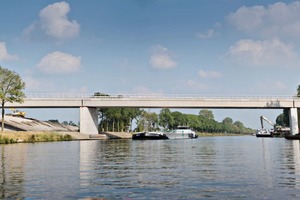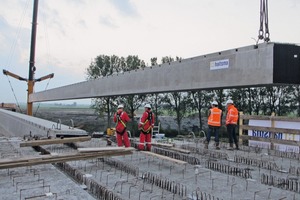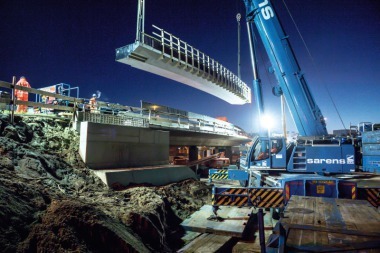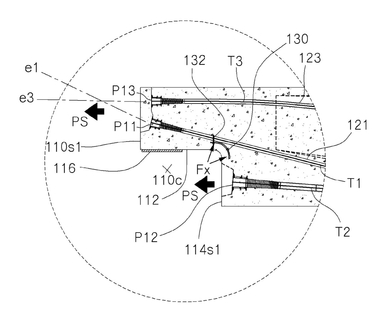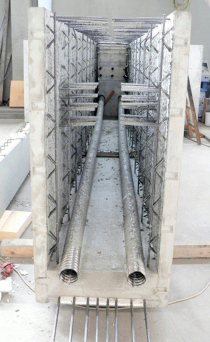Longest box girders delivered to bridge project at Zuidhorn
To relieve the lift bridge across Van Starkenborgh Canal in Zuidhorn, Netherlands, of some of its load and to remove traffic congestion, municipal authorities designed a new, 152 m long bridge with prestressed-concrete girders. This N355 bridge includes a 40 m and a 44 m girder at either end and a central girder spanning over 68 m. Haitsma Beton, a precast producer headquartered in Kootstertille, Netherlands, delivered the longest-ever prestressed box girders weighing 240 tonnes to this project.
Haitsma Beton prestressed-concrete girders open up new prospects for roads and waterways. Their long spans eliminate the need for some of the intermediate piers, which shortens construction time and creates more space for traffic on roads and waterways. As a result, large container vessels can also pass the canal at Zuidhorn.
Robust structure
Prior to commencing construction, feasibility of designing the bridge with large box girders had to be verified. After the related approval, the design was also evaluated in terms of its robustness, aesthetic appeal, joint design, and price. The client opted for a design variant with a perimeter element integrated in the edge beam. Designers decided to specify C90/105 concrete to ensure sufficient strength of the girders despite their limited dimensions. Each of the prestressing strands was prestressed with a force of 210 kN, resulting in a total prestressing force of 25,620 kN. Installers tensioned them in crosswise direction to ensure appropriate distribution of loads across the girders and sufficient overall resistance to traffic loads at the final installation stage.
Precise structural analysis
Design engineers used the central-span and the larger of the two end-span girders as the basis for their structural analysis. Both were modeled as orthotropic decks and dimensioned using an EEM program. Calculation of orthotropy parameters relied on stiffness and torsional rigidity values in the longitudinal and transverse directions as well as on a certain portion of the cross-sectional area relevant to shear forces. The EEM models were subjected to the loads created by the composite action of all girders that results from transverse prestressing or the compression layer. A design service life of 100 years and consequence class CC2 were defined for loading. The carriageway has a total width of 8.51 m, which makes it possible to use tandem loading systems for two lanes. Girders were dimensioned on the basis of all required parameters, including moments, prestressing forces, dead weight, and joints.
The new bridge across Van Starkenborgh Canal was completed after a construction time of about nine months.

